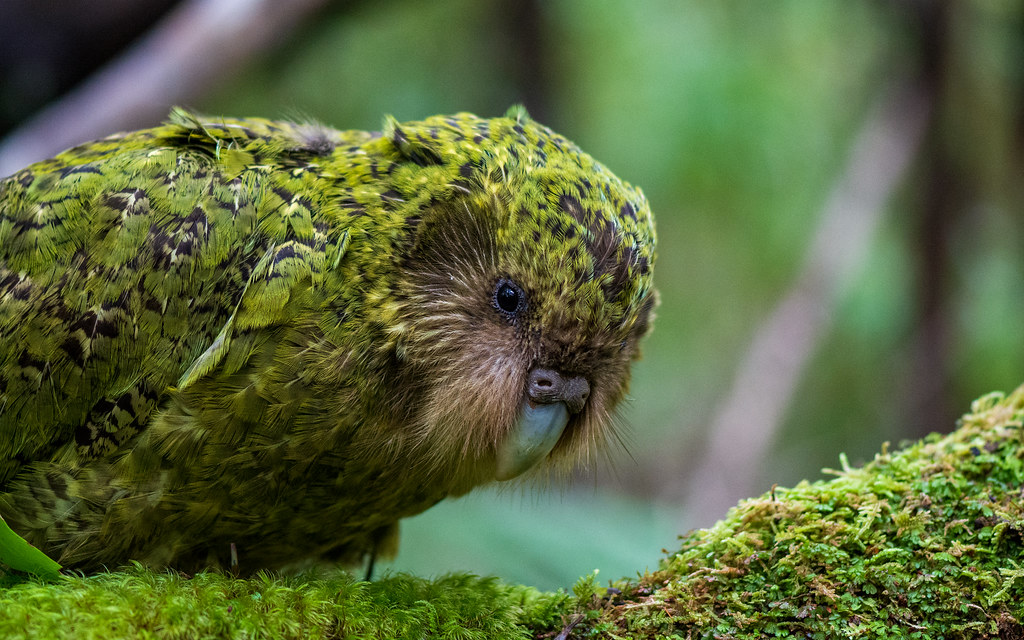Introduction
The Kakapo parrot, a remarkable and critically endangered species, is native to New Zealand’s lush forests and islands. Known for its distinct characteristics, it holds a unique place in the avian world due to its large size, nocturnal habits, and vibrant green plumage. In this article, we delve into the world of the Kakapo, exploring its behaviors, habitat, conservation status, and the challenges it faces.
Physical Characteristics
The Kakapo parrot is a large, flightless bird, with males reaching up to 60 centimeters in length and females slightly smaller. Its distinctive green feathers provide excellent camouflage in the forest, where it predominantly resides. Kakapos have a sturdy build, short wings, and a strong beak adapted for grinding seeds and plants.
Habitat and Range
Historically, Kakapos inhabited both the North and South Islands of New Zealand. However, due to habitat destruction and introduced predators, their range has significantly diminished. Today, their habitat mainly consists of predator-free islands and sanctuaries, where intensive conservation efforts are ongoing.
Behavior and Habits
Kakapos are nocturnal creatures, venturing out at night to forage for food. They are also ground-dwelling birds, preferring to walk rather than fly. Their distinctive mating rituals, involving booming calls and “lekking” behavior, are unique in the avian world.
Diet and Feeding
The Kakapo’s diet primarily comprises native fruits, seeds, and plant material. It has specialized adaptations, such as a keen sense of smell, to locate its preferred foods in the forest understory. The bird’s diet plays a crucial role in maintaining the ecosystem by dispersing seeds.
Breeding and Reproduction
Kakapo breeding is a complex and rare event. Males gather in specific locations to perform booming displays and compete for female attention. Successful breeding is crucial for the species’ survival, and conservationists have implemented various strategies to improve reproductive outcomes.
Conservation Status
The Kakapo is critically endangered, with a population that has dwindled to dangerously low numbers. Habitat destruction and the introduction of predators, such as rats and stoats, have contributed to its decline. Conservation efforts are intensive and ongoing.
Conservation Efforts
Numerous organizations and dedicated individuals are working tirelessly to save the Kakapo from extinction. Conservation programs include predator eradication, habitat restoration, and intensive management of breeding populations.
Success Stories
Recent years have seen some success in Kakapo conservation. Several breeding seasons have produced chicks, offering hope for the species’ recovery. These successes are the result of meticulous planning and continuous monitoring.
Challenges and Threats
Despite progress, the Kakapo faces ongoing challenges. Habitat loss, introduced predators, and limited genetic diversity pose significant threats. The species remains critically endangered, requiring constant vigilance and conservation efforts.
The Role of Indigenous Culture
The Kakapo holds cultural significance to New Zealand’s indigenous Māori people. Efforts to protect the species align with Māori values of guardianship and recognition of the bird’s unique place in their heritage.
Future Outlook
The future of the Kakapo remains uncertain, but ongoing conservation efforts offer a glimmer of hope. With continued dedication, support, and international collaboration, there is a chance to secure a brighter future for this iconic and critically endangered parrot.
FAQs
- What are Kakapo Parrots, and where are they found?Kakapo Parrots, also known as night parrots or owl parrots, are large, nocturnal, flightless parrots native to New Zealand. They are primarily found on predator-free islands and sanctuaries due to habitat loss and introduced predators on the mainland.
- What makes Kakapo Parrots unique in the avian world?Kakapo Parrots are unique due to their large size, distinctive green plumage, and nocturnal habits. They are also known for their extraordinary mating rituals, which involve booming calls and lekking behavior.
- Why are Kakapo Parrots critically endangered?Habitat destruction, primarily caused by deforestation, and the introduction of predators like rats and stoats have led to the critically endangered status of Kakapo Parrots.
- What is the role of Kakapo Parrots in their ecosystem?Kakapo Parrots play a crucial role in their ecosystem by dispersing seeds through their diet, contributing to forest regeneration, and helping maintain the balance of their habitat.
- What conservation efforts are in place to protect Kakapo Parrots?Conservation programs include predator eradication, habitat restoration, and intensive breeding management. These efforts aim to increase the population and genetic diversity of Kakapo Parrots.
- What are some challenges Kakapo Parrots face in their conservation?Challenges include habitat loss, introduced predators, limited genetic diversity, and the complexity of breeding. Ongoing vigilance and active conservation measures are required.
- How can individuals contribute to Kakapo Parrot conservation?Individuals can support conservation organizations, raise awareness about the species, and advocate for sustainable forestry practices. Donations and volunteering with conservation initiatives are also valuable contributions.
